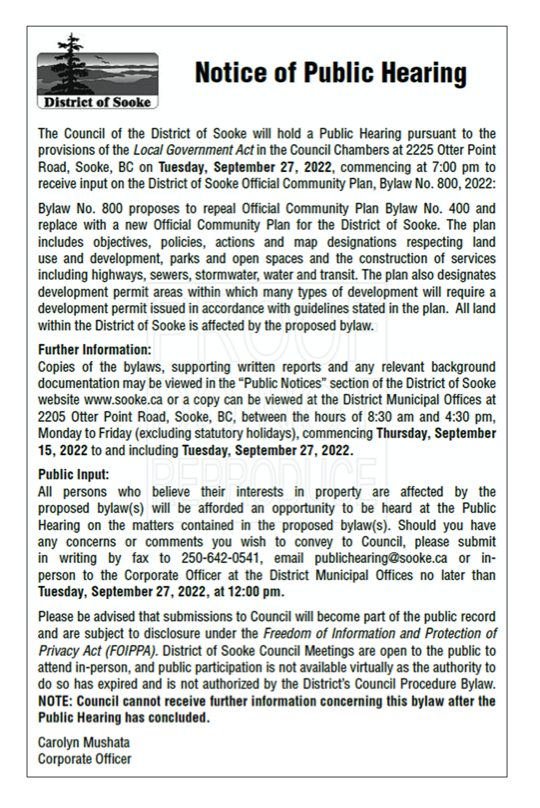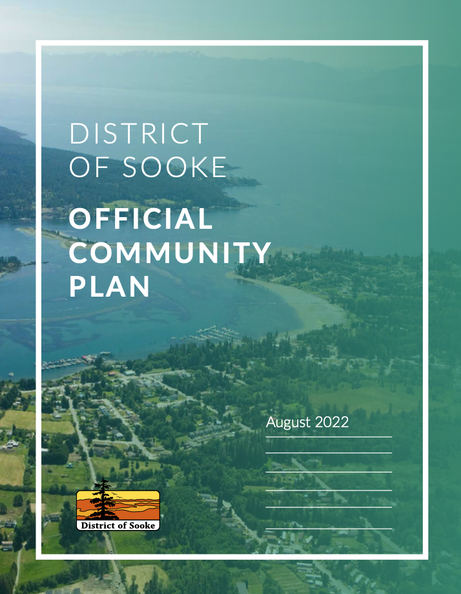A steady trickle (not floodplain's worth) of form emails are arriving in council's mailbox today that read: "I'm opposed to the new OCP with inclusion of any Development Permits. There are additional edits that must be made." That's it and that's all. There is no further explanation about the why and what of their opposition nor citations about required edits. (All along with some fuller correspondence will be included in a supplemental agenda published later this afternoon).
I voted on Sept. 8 in favour of moving us to this public hearing because I am a fan of the plan, first and foremost. I agree with the OCP Advisory Committee (Mrs. Lewers notably excepted in a 6-1 vote) that it is ready for primetime. And I want us to get to this legislated next step (which is still short of third reading and adoption).
As one who strives for consensus decisions, I'm upset that council was divided 4-3 on whether to go to the hearing. I respect my colleagues, especially Mayor Tait, whose leadership, views and opinion I so value. (My father, the Colonel's, voice from beyond urges: Follow your leader!). Calling a halt tonight and allowing the next council to finish the job makes good sense as she explains it. A truce would lead to all quiet on the western front and give time for another round of input, and that is both logical and appealing.
Yet I can't shake the idea that an entirely unpredictable new council crew from the 23 contenders could hijack the process and throw this excellent plan under the bus. [No Development Permit Guidelines? No opportunity for staff to regulate the form and character of new development when it comes to sub-divisions of four or more homes and mixed-use larger projects? Where praytell is the sense in that?]
I have tried my very best to address concerns raised by a small, vocal, influential group by asking questions at our OCP meetings and by writing blog entries like the one that precedes this one.
They will be out in numbers tonight, too, I'm sure, as is the case at all public hearings. (Check out this recent SFU report - https://www.democracydialogue.ca/publichearings. Downsides are captured in this quote: "While a noisy minority tends to dominate public hearings, the silent majority of reasonable people are by definition never heard. Elected officials therefore are forced to pander to the skewed view of the vocal minority of voters present, rather than doing what they have been already elected to do, which is make the best decision for the future of the community overall.")
I'll share the PS from my above-linked blog post in full here with apologies to those of you who prefer the two-line email mode of communcation. Yes, I do tend to complicate things when perhaps I should stick with text-message headlines and bold, context-free statements (this OCP "will clear-cut Sooke," for instance) as others like to do.
Okay, here's the cut-and-paste ...
"Even with all the public feedback to date, I naturally wonder what comments will emerge during the public hearing whenever it's scheduled.
As Councillor Beddows, the OCP Advisory Committee liaison, has noted, council dealt promptly this spring with the major concerns that emerged from the first-wave responses to the draft OCP:
1. The proposed 30m waterfront setback requirement for new subdivisions of four-or-more homes (now reinstated at 15m as per Sooke tradition).
2. Potential density increases in the Whiffin Spit neighbourhood (now returned to its Rural Residential designation).
3. The re-inclusion of phase three of West Ridge Trails in the Community Residential, not rural, designation (while knowing that the development still must secure rezoning and sewer inclusion before it can proceed.)
What else might arise at the public-hearing? I've taken pains to raise concerns from the public engagement packages in my questions to staff during the chapter reviews -- including points raised by Farrell Estates and the Concerned Citizens of Sooke (Randy Clarkston, Dave Saunders, Dave McClimon, Matt Mortenson and Brian Butler). Both Councillor McMath and I drew questions from the latter's correspondence at the July 19 chapter review re: DPA overreach, the "hidden density issue," transportation and costing.
Certainly there's been confusion over the so-called "hidden density issue" during OCP deliberations. The proposed bylaw's Growth Management and Land Use section (starting on pg. 57) cites a maximum density of 70 units per hectare in the Community Residential designation (i.e., the Sewer Specified Area west of the Sooke River).
Does this mean that Community Residential landowners would be free to dramatically densify their single-family lots and we'd see cluster housing on what are now single-family streets, turning Sooke into wall-to-wall suburbia? What a nightmare!
I personally have asked staff in public meetings about this at least four times now in response to public concerns. They and the OCP consultants have replied with what the document itself (pg. 60) states: "Maximum densities within each designation will be informed by the policy direction of the OCP and the site-specific zoning provided in the Zoning Bylaw."
The OCP policy direction is for density in the Town Centre Core, Town Centre Transitional and Town Centre Waterfront designations. Period. (And up to a point: The 2009 Town Centre Plan, which is due to be revised as a first priority action following OCP adoption, envisions net growth in the TC of 1400 residents by 2050.) It in no way recommends density (i.e., sprawl) beyond this town centre.
A new Zoning Bylaw is required following the adoption of every new OCP in BC. Our pending OCP allows six-storey buildings in (zoning-specified spots only) north of Sooke Rd. in the Town Centre and only along the two sides of Brownsey Blvd. south of it. (Interestingly, the current zoning bylaw's High-Density Multi-Family RM-4 category allows a maximum of 90 units per hectare. Ayre Manor and West Wind Harbour are the only spots so designated. The CD7 zoning for Mariner's Village allows 50 units per hectare maximum.)
Regarding costing, no OCP I've ever seen includes a price tag for proposed actions. Instead, they are subject to cost analysis when prioritized by council and staff for consideration in each successive year's Five-Year Financial Plan. If the money's not there or the tax hit too heavy, then a specific action remains on paper and aspirational, as so many have done in the 2010 OCP. Still entirely worth honouring community OCP input, however, by capturing our wishes and best aspirations on paper, of course.
[Predicted capital expenses in 2020 dollars are, however, included for actions recommended by theTransportation (pg. 67-69) andParks & Trails (pp. 71-75) master plans. There are also very loose estimates of costs for Appendix H items in theClimate Action Plan, whose one $$$ item relates to implementation costs for those same master plans. See my lengthy explanation in the PPS below.]
The plan concludes with a set of Development Permit Area (DPA) guidelines that are critical in particular for the town centre as growth picks up momentum. They include Sooke's first set of DPAs for "energy and water conservation, and greenhouse gas emissions reductions,"permitted by the Local Government Act not long after BC introduced (and Sooke promptly signed) the B.C. Climate Action Charter in 2008.
I believe this is where the OCP is criticized as being "overly perscriptive," yet I'm not sure how these flexible rules, applicable on a case-by-case basis, can be anything but exact and on point. As the province states, they "govern locations that need special treatment for certain purposes, including the protection of development from hazards, establishing objectives for form and character in specified circumstances or revitalization of a commercial use area."
Some municipalities include these guidelines in their zoning bylaws, others in their OCPs. I honestly can't fathom suggestions from some that the the DPA section be axed entirely, especially after seeing how the guidelines are so central in ongoing staff/developer negotiations re: the mixed-use proposal for Brownsey Blvd.'s west side. How else can we ensure the community gets what it wants and expects from incoming developers as determined by documents like the Town Centre Plan?
(DPA exemptions apply, incidentally, to anyone building a single-family home, duplex or accessory building, those needing to remove hazardous trees or undertake yard and garden landscaping, among other exceptions. See pg. 178/79.)
Unsurprisingly, the OCP conversation this year has been led by a minority with specific concerns. These concerns are absolutely valid, as are those of all 15,086 (2021 census) residents of Sooke. It's great that other engagement methods -- online surveys, community sounding boards, virtual stakeholder consultations with numerous community groups and organizations, school sessions and more -- captured wide input, too, but arguably less than had COVID not struck and eliminated in-person town halls and the like."


 RSS Feed
RSS Feed